* restored/texts collaged from numerous sources incl. Film Comment, io9, indiewire, Open Culture, flavorwire, a.o.

Love Birds In Bondage (Quentin Tarantino)
Tarantino co-wrote Love Birds In Bondage with Scott Magill or McGill. Tarantino would go on to co-produce and co-direct the film. Magill committed suicide in 1987, but not before destroying all footage that had been shot. The film concerned a young woman who suffered a traumatic brain injury after an accident leading her to act erratically. She is institutionalized in a mental hospital and her boyfriend figures out a way to get himself admitted. Tarantino also played the boyfriend.
Waiting for Godot (Roman Polanski)
Polanski proposed a film adaptation of the play to Beckett, who politely refused to allow it. Beckett insisted that the play was not cinematic material and that an adaptation would destroy it. He asked for Polanski’s forgiveness and that the director not dismiss him as a “purist bastard.”
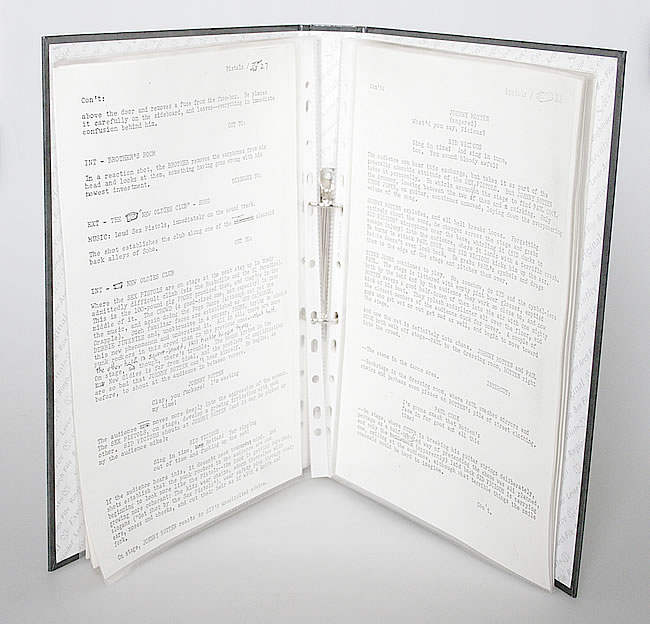
Who Killed Bambi? (Russ Meyer, 1978)
Intended as a punk rock version of A Hard Day’s Night, the film was to star the Sex Pistols. It was to be based on a screenplay by Roger Ebert and Malcolm McClaren. According to Ebert, “McLaren claimed 20th Century-Fox read the screenplay and pulled the plug. This seems unlikely because the studio would not have green-lighted the film without reading the script. Meyer called me to say McLaren had made false promises of financing and was broke. The film’s fate was sealed when Princess Grace, a member of the Fox board, said, “We don’t want to make another Meyer X film.” Some footage was shot by Meyer, but not much, perhaps several days’ worth, and it wound up in Julien Temple’s The Great Rock ’n’ Roll Swindle.
A Confederacy of Dunces (John Waters, 1980s)
Adaptation of the novel by John Kennedy Toole about a corpulent, flatulent medievalist. The role was considered for John Belushi, John Candy, and Chris Farley, all of whom died before anything could be realized. Waters, who for a time had lived half a block from Toole’s mother (Thelma Ducoing), wanted the part for Divine before his death and pitched for the job of director, and lost it when the producer saw a photo of him, in his book Shock Value, visiting Manson Family member Charles ‘Tex’ Watson – who had killed one of the producer’s best friends.

CONFUSION. LECTURE BRUITÉE D’UN SCÉNARIO NON-RÉALISÉ DE JACQUES TATI
Confusion (Jacques Tati)
In a media-obsessed future Paris, society is glued to communication technology and little distinction is made between fiction and reality. Tati was planning to collaborate on the film with the band Sparks, who were to play two American TV execs. Action centers around the mishaps within the studio facilities of fictive media conglomerate COMM. During the live broadcast of a scripted drama filled with stagy theatrics, a mistakenly loaded gun kills an off-screen Monsieur Hulot. The cameras keep rolling, with cast members discreetly stepping over the fresh cadaver during their scenes, while the crew scrambles to remove it from sight.

King Shot (Alejandro Jodorowsky)
Co-produced by David Lynch, it was to star Asia Argento, Jeff Bridges, Marilyn Manson, and Udo Kier in a “metaphysical western set in a desert casino, featuring a man the size of King Kong and Marilyn Manson as a 300-year-old pope.” The film’s storyboards are available here.
Women (Paul Verhoeven)
To be adapted from Charles Bukowski’s fictionalized account of his experiences (and frequent dissatisfaction) with sex and romance.

The Bells of Hell Go Ting-a-Ling-a-Ling (David Miller, 1966)
‘This was my first film role, co-starring with Gregory Peck, who was a huge movie star at the time. He was not well-cast as an English army Colonel — he repeatedly addressed me as ‘Loo-tenant’: and when I repeatedly corrected his pronunciation (in UK we say ‘Left-tenant’), the director David Miller told me to shut up. ‘Never forget Ian, Great Britain is only 5% of the world market.'” The story was that a squad of British airmen attempt to smuggle plane parts into enemy territory with the aim of reassembling them and attacking German targets. It was a disaster. After five weeks filming, the summer was invaded by early snow which was forecast to persist through the following six months. The shooting was already behind schedule so Mirisch cut their losses by abandoning the film and sending us home — me with 4000 pounds.’ — Ian McKellen
To the White Sea (Joel & Ethan Coen, 2001)
The Coens wrote a nearly dialogue-free adaptation of James Dickey’s 1993 novel about a WWII American fighter pilot who, shot down on a mission over Tokyo in 1945, murders his way through the outskirts of the fire-bombed city. Brad Pitt was set to play the brutal protagonist, with Jeremy Thomas producing. The Coen Brothers’ decision to actually shoot the film in Japan proved to be the project’s downfall as it already had been a struggle for the Coens to convince 20th Century Fox to take this violent, experimental movie on.
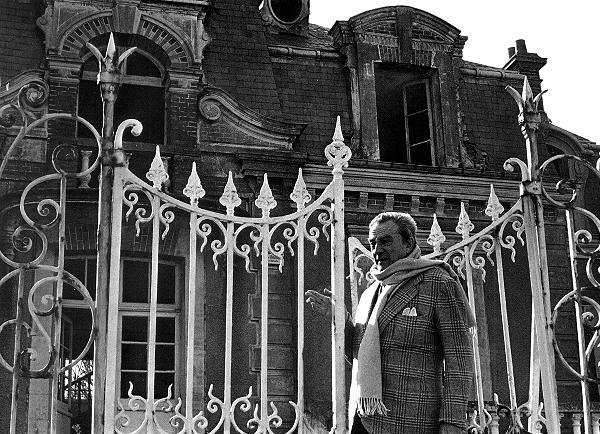
Luchino Visconti in France in 1971 scouting locations for ‘A la recherche du temps perdu’
À la recherche du temps perdu (Luchino Visconti, 1969)
In 1969 Visconti commissioned a script by Suso Cecchi d’Amico. Visconti conducted rigorous research around Paris and the Normandy coast. The usual collaborators were retained: Nicole Stéphane (who owned the rights), photographer Claude Schwartz, costume designer Piero Tosi, and set designer Mario Garbuglia. Silvana Mangano was to play the Duchesse de Guermantes, Alain Delon or Dustin Hoffman the narrator-protagonist Marcel, and Helmut Berger the homosexual protégé of Baron Charlus, Charlie Morel. The proposed four-hour film boasted a huge cast and an accordingly huge budget for which financing could not be secured. Laurence Olivier and Marlon Brando were considered for role of Charlus.
In a Dream of Passion (Monte Hellman)
Hellman’s adaptation of Alain Robbe-Grillet’s novel, La Maison de Rendez-Vous, about an American’s experiences in a Hong Kong brothel, was to be produced by Roger Corman.
Batman-Dracula (Andy Warhol)
Thought to be the first campy portrayal of Batman, Andy Warhol directed the film without the permission of DC Comics and only showed it at his own exhibitions. Warhol’s friend, the appropriately named Gregory Battcock, played Batman, while Baby Jane Holtzer played Catwoman. While the film itself is unavailable, some scenes are shown in the documentary Jack Smith and the Destruction of Atlantis. Smith played Dracula.
A Scanner Darkly (Charlie Kaufman)
Kaufman said he wrote this script soon after Being John Malkovich: “I got it as an assignment. There was a director attached, an Australian woman named Emma(-Kate) Croghan. She had just directed an independent comedy [Strange Planet] and she was attached to the project by Jersey Films and then they brought me on.” And then the studio lost interest. Kaufman’s script is easy to find online, but Kaufman says you should just read the book instead. “What’s the point if you’re going to read the book? Certainly my version doesn’t offer anything that the book doesn’t! At the time, I felt like I was trying to do something that was respectful of the Dick book. I felt like the movies coming out based on his books had nothing to do with his books.”
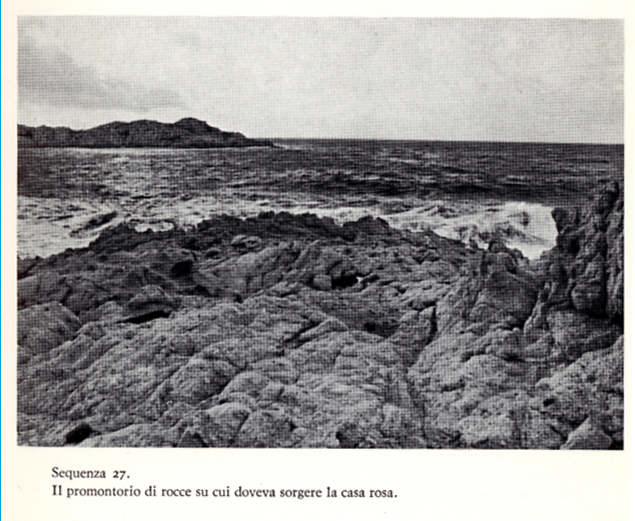
Technically Sweet (Michelangelo Antonioni)
The director worked on this screenplay in the late Sixties and envisioned Jack Nicholson in the lead role as a man lost in the Amazon wilderness after surviving a plane crash. Some production stills from the unrealized film are available here.
Suffer or Die (Michelangelo Antonioni)
Scripted by Tonino Guerra and Anthony Burgess, it was to star Debra Winger alongside Mick Jagger or Richard Gere or Giancarlo Giannini as an architect. Amy Irving was cast at one point as a Catholic novice.
Uncle Tom’s Fairy Tales (Penelope Spheeris)
The film was a collaboration between legendary comic Richard Pryor, in what would have been his first major film role, and then film-student Penelope Spheeris. David and Joe Henry‘s recent biography of Pryor, “Furious Cool,” says that the film was about a group of Black Panthers who abduct a wealthy white man and put him on trial for all racial crimes in the history of America. According to “Furious Cool,” Spheeris had apparently assembled about 45/50 minutes of the movie — they were working towards a cut that they would show Bill Cosby, who it was hoped would attach his name to the project, presumably as a producer. She screened it to Pryor in the basement of his house, with the film then collecting in a bin under the Moviola, when Pryor’s second wife Shelley Bonis stormed in, furious with her husband. According to Spheeris, Pryor and Shelley fought until the comic, screaming “You think I love this film more than you? Watch this?,” picked up the negative and tore it into pieces. Spheeris spliced the fragments back together as best she could, and they screened the results to Cosby, who may or may not have bought the negative (Pryor’s memoirs says that Cosby agreed to pay for a final edit, then commented “Hey, this shit is weird,” convincing Pryor to shelve the film, only for the negative to be stolen from his house, while Spheeris speculates that Cosby buried the movie to hurt Pryor, his main competition).

Freud (John Huston/Jean-Paul Sartre)
In 1958, legendary director John Huston decided to make a film about the life of Sigmund Freud. Having met Jean-Paul Sarte in 1952 during the filming of Moulin Rouge, Huston felt the philosopher would be the ideal person to script the Freud film, since Sartre knew Freud’s work so well and since Huston surmised that he would have “an objective and logical approach.” Ironically both Sartre and Huston considered themselves anti-Freud for largely the same reason: Sartre because as a Communist he believed the role of the psychoanalyst was limited and of little social importance. For his part Huston felt that psychoanalysis was an indulgence for bored house wives and the problem children of the rich while the “movers and shakers”’ were too busy for it and those that most needed it couldn’t afford it. First, Sartre delivered a modest 95-page treatment. This, however, became a 300-page draft in 1959 that Huston calculated would produce an unacceptable five-hour-long film. When Huston and Sartre met in person in Galway to find a way to cut the screenplay down to a reasonable length, their working relationship was less than cordial. In Huston’s recollection, Sartre was “as ugly as a human being can be.” Sartre’s remembrance is hardly more flattering of Huston: “…in moments of childish vanity, when he puts on a red dinner jacket or rides a horse (not very well) or counts his paintings or tells workmen what to do. Impossible to hold his attention five minutes: he can no longer work, he runs away from thinking.” After their Galway meeting, during which Huston tried and failed to hypnotize Sartre, the philosopher attempted another revision, but this time, he sent Huston an even longer draft, for an eight-hour film. At this point, Huston gave up on Sartre.
The Story (Jean-Luc Godard)
In the late 1970s Jean-Luc Godard became obsessed with the story of Siegel and planned to make a movie about him. He wrote a screenplay called, simply, “The Story”, and planned to cast Robert De Niro and Diane Keaton in the Siegel and Hill roles. He dropped this plan when Keaton lost interest and then turned his attention to Every Man for Himself (1980) as his return to commercial filmmaking.
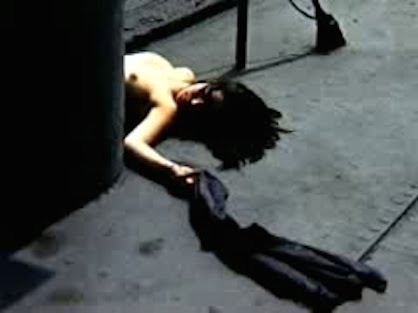
Kaleidoscope (Alfred Hitchcock, 1964-67)
After watching Antonioni’s Blow-Up, Hitchcock felt he was a century behind the Italians in technique. He asked the novelist Howard Fast to sketch a treatment about a gay, deformed serial killer. Pleased with the results, Hitchcock composed a shot list with over 450 camera positions and shot an hour’s worth of experimental color tests. MCA/Universal were disgusted by the script and immediately canceled the project, reducing Hitchcock to tears. See the images, parts of the script, and test footage.
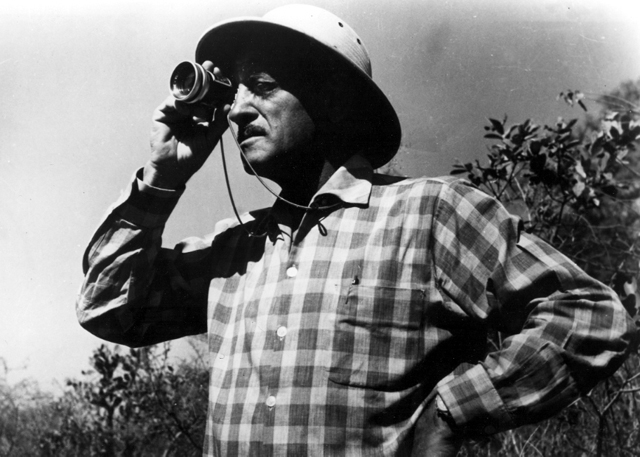
Bunuel in Mexico researching A Sumptuous Ceremony
A Sumptuous Ceremony (Luis Buñuel)
At four o’clock one afternoon Luis Buñuel decided that he would make no more films. He was staying in the spa at San Jose Purua in southwest Mexico where, for more than twenty years, Buñuel had gone to write his scripts. It is a semitropical paradise set in a green canyon — a bit too hot, in truth, for Buñuel liked rain, fog, the north. The screenplay was for a film to be called A Sumptuous Ceremony, in homage to Andre Breton, who defined eroticism as “a sumptuous ceremony in an underground passage.” From the outset the watchwords were “terror” and “eroticism.” Bunuel imagined a young girl in a prison cell receiving a visit from a phantom bishop; a trap door led to an underground passageway and to a boat filled with explosives for blowing up the Louvre museum. The script was never finished. Buñuel had barely arrived in San Jose Purua when he felt unwell, ill at ease (this was 1979 and he was therefore seventy-nine years old). He spoke of some “menace,” and at four o’clock in the afternoon he announced that his life as a filmmaker was over.
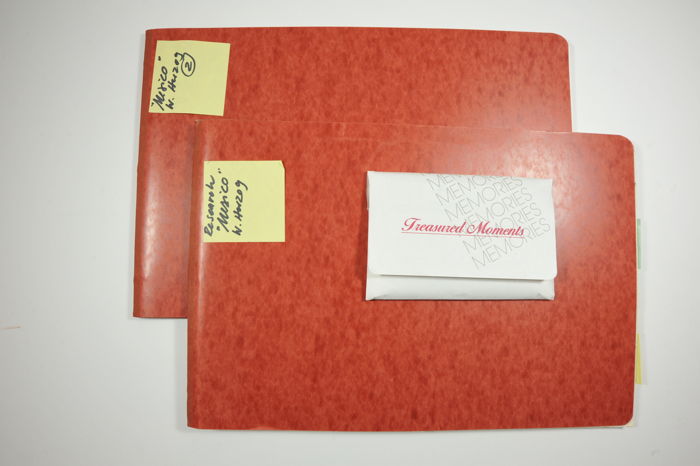
The Conquest of Mexico (Werner Herzog)
Planning to take the perspective of the conquered Aztecs, Herzog said the film would be so expensive that it could only be made with the backing of a Hollywood studio. “I am currently working on a film about the conquest of Mexico and Francis Ford Coppola is involved,” Herzog said at the time. “But I am not making a Hollywood film. Somehow it will still be a Bavarian film. I have nothing against what they do in Hollywood. It doesn’t bother me. Let them do it.”

David Lynch storyboard for Ronnie Rocket
Ronnie Rocket (David Lynch)
A comedy starring a reanimated dead teen, set in a rundown, industrial future. Screenplay available here.
One Saliva Bubble (David Lynch, 1987)
An early project of Lynch and Mark Frost written almost a year before the Twin Peaks pilot. A saliva bubble from a country bumpkin working at a top-secret military base gets into a weapons system, causing the device to fire upon Newtonville, Kansas, and prompting the townsfolk to switch identities with one another. Lynch called it “an out-and-out wacko dumb comedy”; Martin Short and Steve Martin were initially attached to star. Screenplay is available here.
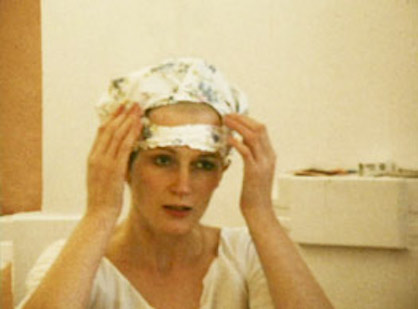
Heartbeat in the Brain (Amanda Feilding)
After shaving her hairline, donning a floral cap and constructing protective eyewear from a pair of sunglasses and medical tape, 27-year-old art student Amanda Feilding injects herself with an anesthetic, peels the skin from her forehead with a scalpel, and begins to drill into her own frontal bone with a foot operated dentist’s drill in this documentary/art piece about the “science” of trepanation. A reviewer who saw the film in 1978 reported that when Feilding finally drills through the bone and grins victoriously as blood spurts down her face, several members of the audience fainted, “dropping off their seats one by one like ripe plums.” The film hasn’t been seen in 44 years. It is assumed that Feilding has a copy.
Pincushion (John Carpenter)
Postapocalyptic odyssey was to star Cher, whose character must deliver a life-saving serum to Salt Lake City. John Raffo scripted.
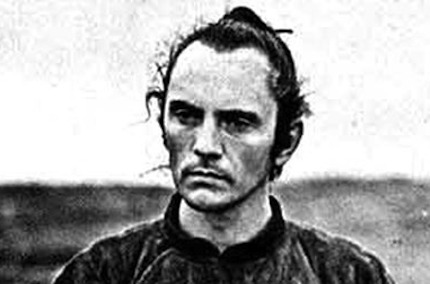
Hu-Man (Jérôme Laperrousaz)
An actor (Terence Stamp, playing himself) is placed in a series of dangerous situations, while his fear is broadcast to the television audience. Their emotional reactions will determine whether he is sent into the future, or the past. Directed by Jérôme Laperrousaz, a highly elusive figure whose other films include the almost equally obscure documentary Amougies (Music Power – European Music Revolution) and the Bob Marley-starring musical Third World, and co-starring Jeanne Moreau, Hu-Man won the Trieste Festival of Science Fiction Films in 1976, but has fallen into obscurity, and apparently no prints exist.
L’Ailleurs immédiat (Jean-Pierre Gorin)
In the director’s first solo film, Gorin played the lead, reciting passages from Nietzsche’s Genealogy of Morals while getting tattooed, and masturbating on a Paris window ledge. The film was reportedly destroyed by the producers before completion, after the drug arrest of the lead actress.
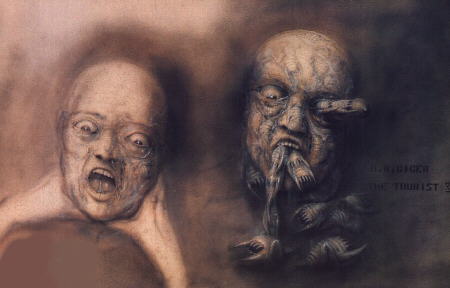
The Tourist (Claire Noto)
Noto’s script, started in 1980, has often been cited as similar to Blade Runner, and its moody, atmospheric, and unexpectedly sexual overtones also suggested the alienation and tragic nature of The Hunger and the exotic mien of the creatures from Ridley Scott’s Alien. It languished in development hell forever, while its ideas proved so popular that it was plundered time and again, most blatantly by Men In Black which mostly lifted the concept wholesale, added heroic human agents as the leads, jettisoned the existential woe of estranged aliens, trapped and in-hiding on Earth, and of course made it a comedy. Legendary visualist H. R. Giger created a series of alien designs in the early 1980s and they, like the script, were much too sexualized and unsettling for the execs who were trying to grapple with an unwieldy story of morality, corruption, xenophobia, humanity and imprisonment, both physical and psychological. Citing influences such as Fellini and Antonioni, Noto once said of the screenplay “I wanted to portray sexual agony and ecstasy in a way I’d never seen before, and science fiction seemed like the arena.” But in development hell she remained, though briefly flirting with Francis Coppola’s Zoetrope Studios, before they went broke (legal problems began here, as another producer claimed she co-owned the option). Noto’s difficult nature saw her kicked off her own creation, which then spent years in the studio system (Universal, WB, Paramount, Joel Silver all being involved) as it was overdeveloped into something less nihilistic and more homogenized. And also, bland. In the end, it was a dark independent movie that should have stayed that way. Unfortunately, the Fox Searchlights of the world didn’t exist yet, thus the only option for the project was the studio world where it just didn’t fit. HR Giger’s conceptual drawings for the film are available here.
The Corrections (Noah Baumbach, 2012)
Scott Rudin was to produce this HBO miniseries adaptation of Jonathan Franzen’s novel. Ewan McGregor, Chris Cooper, Dianne Wiest, Maggie Gyllnehaal, Greta Gerwig, and Rhys Ifans were cast and shooting began before HBO cancelled the project. According to Baumbach, “We shot a pilot, but we didn’t shoot a whole pilot, even. It was never finished.”

Napoleon (Stanley Kubrick, 1969-70)
A biopic on Napoleon set to be made just after the success of 2001: A Space Odyssey. Kubrick was so enthusiastic to make the project that he confessed to identifying with Bonaparte down to the way he ate his food. Jack Nicholson was slated to play the title character, but when corporate changes hit MGM, Kubrick lost the approval.
The Lord of the Rings (Stanley Kubrick)
In the late 1960s, The Beatles worked for a year on a project in which they would star in an adaptation of Tolkien’s novel. The plan was that Paul McCartney would play Frodo Baggins with Ringo Starr backing him up in the role of Sam Gamgee. George Harrison would don a hat and grow his beard a little longer to take on the role of Gandalf and John Lennon decided that for him only the role of Gollum would do. They even went as far as to Stanley Kubrick to direct the film. Kubrick did consider it, citing the sheer immensity of the book as a reason for his declining The Beatles’ offer. The project finally died due to the increasing animosity between band members.

The Moviegoer (Terrence Malick)
Adaptation of Walker Percy’s novel about a Korean War vet turned stockbroker whose traumatic experiences cause him to search for life’s deeper meaning, heading for New Orleans. Malick abandoned the idea after Hurricane Katrina devastated the city, where the film was to take place.

The English Speaker (Terrence Malick)
This highly personal passion project was based on the pioneering study by “talking cure” proponent and Freud forerunner Josef Breuer of 1880s psychoanalysis patient Anna O, a hysteric given to melancholia, personality changes and a form of aphasia in which she could understand only German, but replied in English, French or Italian. The screenplay, according to producer Bobby Geisler, one of the very few people ever allowed to read it, was “as if [Malick] had ripped open his heart and bled his true feelings onto the page,” while author Peter Biskind described it as “The Exorcist as written by Dostoevsky.” But perhaps because he felt so passionately, the project got sucked into the whirl of controversy and recrimination that surrounded the tortuous process of getting The Thin Red Line to screens. Malick in fact held the finishing of his war elegy for ransom, demanding in perpetuity rights over The English Speaker to ensure no one but him could direct it. The producers held out, though, and in the dust cloud thrown up by the eventual breakdown of the relationship between Malick, Geisler, and The Thin Red Line producer Mike Medavoy, it’s hard to see exactly where the rights landed.
Mona Lisa (Larry Clark)
Remake of Neil Jordan’s 1986 underworld thriller to star Eva Green and Mickey Rourke, or Rosario Dawson and Hayden Christensen.
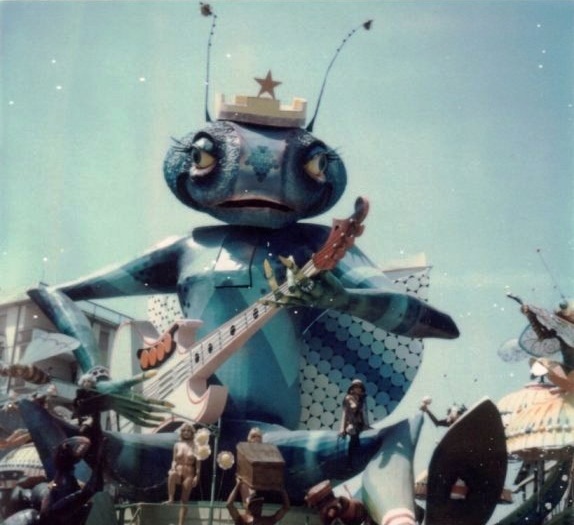
Maldoror (Alberto Cavallone)
This is a holy grail amongst film collectors, matched only by The Day the Clown Cried. There was no one more qualified to adapt Comte de Lautréamont’s infamous novel than director Alberto Cavallone, who made a number of grotesque/erotic art films, which were in vogue at the time. Cavallone’s adaptation was completed, though never publically screened, making the film as impenetrable as its source material. Finding a copy would be, in the words of the Comte himself, as “beautiful as the chance encounter of a sewing machine and an umbrella on a dissecting table.” A detailed account of the film’s history by Mike Kitchell is available here.
La Belle vie (Robert Bresson)
Bresson received “advance-on-box-office” French funding in 1986 for the project.

Genesis (Robert Bresson, 1963)
A lavish adaptation of the Book of Genesis that Bresson wanted and tried to make off and on for 35 years. The story would have had to span the creation of the universe all the way to the building of the Tower of Babel. And back in the day, Bresson didn’t have Terrence Malick’s VFX team for “The Tree of Life.” Dino De Laurentiis had agreed to finance, but Bresson abandoned the project only to take it up again and then abandon it a second time. He once said that one of the frustrations with the production was that he couldn’t make his animal performers do as they were told. He would try to mount the project one more time in 1985, thanks to “an exceptional pre-production grant” he had received, but this attempt failed too.
Gershwin (Martin Scorsese, 1981)
Paul Schrader and John Guare wrote drafts of the script for this biopic about the American composer George Gershwin. Lavish production numbers of Gershwin’s works were to be related to scenes from his life as discussed by Gershwin on a psychologist’s couch. The movie was owed to Warner Bros., but they were eventually interested in another Scorsese picture (they also were skeptical about the cost/return prospects on “Gershwin”). “Ultimately, when it was time to do Gershwin, they turned to me and said, ‘We’d rather have one on Dean Martin,’ ” Scorsese said circa 2004. The problem was, while Tom Hanks was eyed for the lead of Dino (Martin’s birth name), and Nick Pileggi (the author and screenwriter of Goodfellas and Casino) was going to write the script, that one wasn’t even started, while Gershwin was ready to roll. WB wouldn’t budge. The project was finally canceled for good due to complications with rights and the fear that a young audience would not understand or care about Gershwin.
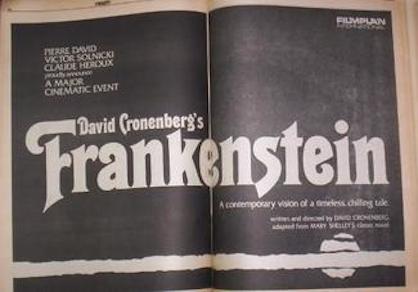
Frankenstein (David Cronenberg)
Canadian film producer Pierre David approached Cronenberg in the ’80s with the idea and the filmmaker offhandedly said yes. “He said, ‘Listen, tell me what you think… David Cronenberg’s Frankenstein?” Cronenberg recalled of the producer’s pitch. He replied “Sounds good to me. What about poor Mary Shelley?” And the next thing Cronenberg knew, there was a full-page ad in Variety touting, “David Cronenberg’s Frankenstein.” Evidently, Cronenberg did think about it a little bit. “It would be a more rethinking than a remake. For one thing I’d try to retain Shelley’s original concept of the creature being an intelligent, sensitive man. Not just a beast,” he is quoted as saying in the collection of interviews Cronenberg on Cronenberg, but, beyond that nothing seemed to happen.
Master of Lies (Nicolas Roeg)
This modern-day Jekyll-and-Hyde story was to star Donald Sutherland as a celebrated author who suffers from attacks of blindness. A story of parallel protagonists in which one man’s destructive fascination for another masks his desire to become him. Jamie Sives and Shirley Henderson were to co-star, with Eddie Dick producing.

Dumbo 2 (Walt Disney Studios)
Dumbo 2 was to be a direct-to-video sequel. It would of taken place a day or so after Dumbo ended. Now that Dumbo isn’t considered a freak (as he’s bringing in major bank for the circus) he’s made a group of super cool and hip friends. The premise: Dumbo and his circus buddies have to figure their way out of the big city after the circus train accidentally leaves them there. When John Lasseter became the Creative Director for Disney, he put a stop to all Disney sequels. Because instead of introducing children to the classics like intended, the sequels often tarnished the spirit of the original films. And it’s not surprising that Lasseter wouldn’t want the same thing to happen to his favorite film. The sequel was so far along that a “behind the scenes” trailer was actually released.
Maldoror (Kenneth Anger, 1952)
A film based on the work of proto-surrealist poet Comte de Lautréamont. Production never went past test footage and rehearsals with ballet dancers for the film from the companies of Grand Ballet du Marquis de Cuevas and the Ballets de Paris of Roland Petit. The footage and information about the film are lost.
Spike Jonze Harold & The Purple Crayon Test Film
Harold and The Purple Crayon (Spike Jonze)
The film was an adaptation of an adaptation of Crockett Johnson’s novel Harold & The Purple Crayon. Jonze worked on the movie for a year and half, but said by that time the vision of the movie had veered off course from its original aims, due to studio notes and interference. “I wanted it to be almost like this silent animation, going back and forth between live action and animation,” he said, but after 18 months it had transformed into something else. “When we finally got the plug pulled I got this amazing sense of relief.” Jonze and his team took a giant 6-foot Purple Crayon replica that was made during development and pitched it off a six story roof in downtown Los Angeles in an anti-form of celebration. “We watched it shatter and I was just so relieved. And I realized over the course of a year and a half, I’d let the studio anxiety—’It’s gotta be funny,’ ‘It’s gotta have snappier dialogue,’ ‘This is too sad,’ ‘This is too melancholy’— and it happened millimeter by millimeter. A year and a half later.
The Idiot (Andrei Tarkovsky, 1986)
Throughout the 1970s, Tarkovsky tried and failed to make a film version of Dostoyevsky’s novel The Idiot. According to Tarkovsky’s younger sister, Marina Tarkovskaya, adapting the novel was a lifelong dream and the state-funded and controlled Russian government (who had to approve all such movies) would never let him make it and kept stringing him along. “Andrei dreamed about filming [it], but they casually told him: ‘You are too young and inexperienced. Let some time pass!,” she told the Voice Of Russia in 2012. “In the end, they kept feeding him with promises for 10 years, and that cherished dream of his life was never realized. Let me stress that Andrei was never a dissident, but the leaders of the USSR still perceived him as a stranger, a person with internal freedom, that was what they could not forgive.” An August 1983 letter from a Russian Deputy Chairman, confirms that Tarkovsky had signed a contract to write an Idiot screenplay for Russian film studio Mosfilm, but in an 1984 Italian press conference, Tarkovsky declared he would never return to the home country. He then passed away three years later at the age of 54.
Where the Wild Things Are (John Lasseter)
In 1983, future Pixar honcho and director John Lasseter directed a 30-second film test of Maurice Sendak’s Where the Wild Things Are, which Disney then owned the rights to and were planning to make into an animated film. Lasseter was asked to do an experiment to see if it would be feasible to hybridize hand-drawn character animation with 3D backgrounds. Studio heads decided the technique was “too expensive” and “what they do on Futurama,” and Lasseter was fired shortly after.
Cocaine (Rainer Werner Fassbinder, 1980)
Fassbinder said of his flashback-centered film based on Pitigrilli’s 1921 novel: “Cocaine freezes the brain, freeing one’s thoughts of anything inessential, and thereby liberating the essential, the imagination, concentration, and so on. This freezing of the brain . . . will be expressed in the film as follows: everything visible will appear covered with a sort of hoarfrost, glittering ice, whether in winter or summer; glasses and windows will covered with ice flowers, and with all the interior shots in the studio, even in summertime, the actors’ breath will be visible, as is usually the case only when it’s bitter cold outside.” This film was supposed to be a big budget production. It had an announcement at the festival in Cannes in May 1982, which Fassbinder and the producer attended. The problem was that because Fassbinder’s script was so big (about 600 pages) the producer asked him to think about shortening it. Since Fassbinder wasn’t in the mood to cut it quickly, he proposed to shoot other films first. He died without ever going back to it.
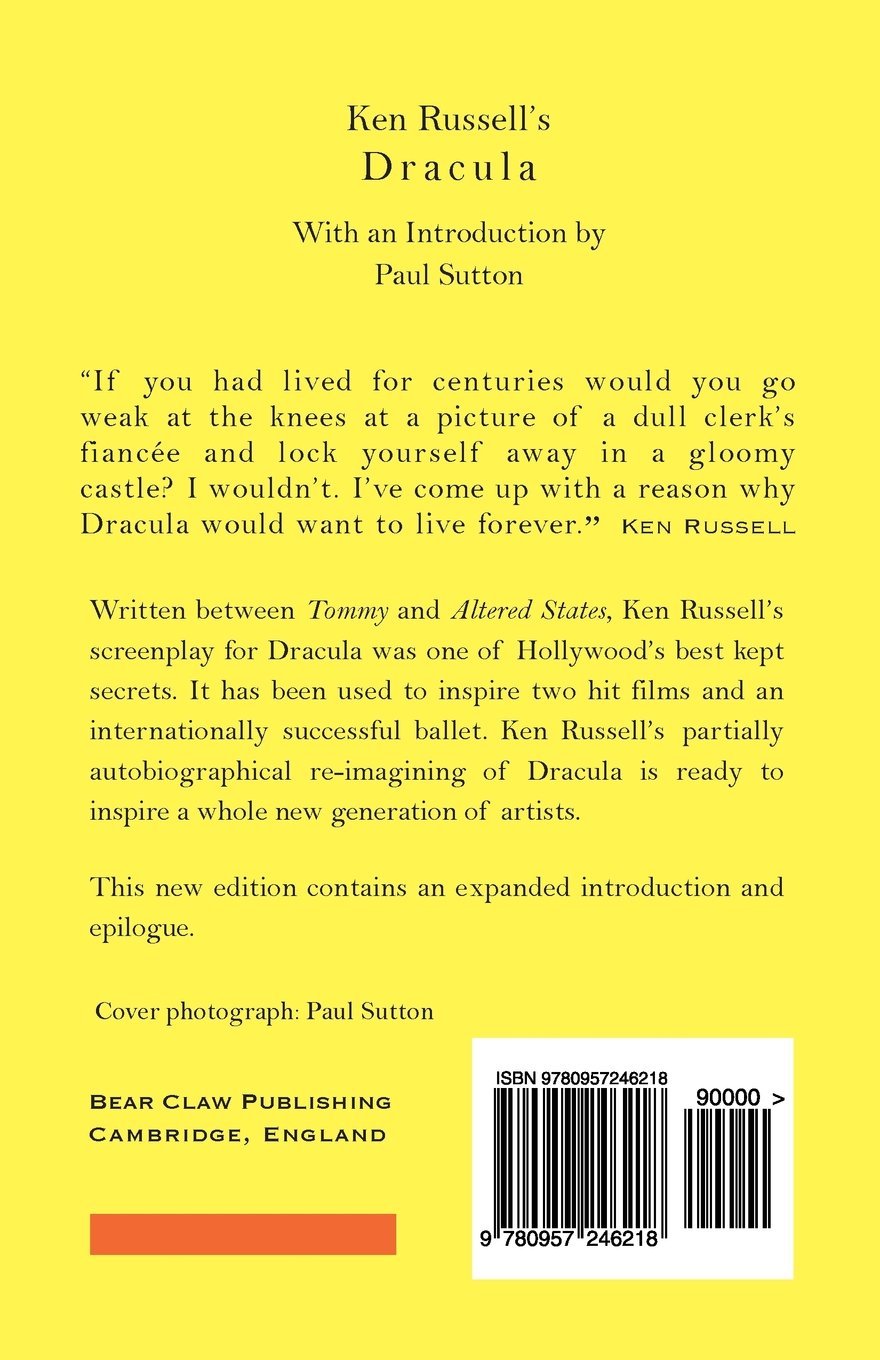
Dracula (Ken Russell)
A “sex-propelled” comic script was written in 1978 as a star vehicle for Mick Fleetwood. The aesthetic was to draw on Aubrey Beardsley (an artist admired by this version of the Count, an arts philanthropist).

Giraffes on Horseback Salad (Salvador Dalí)
The screenplay was written for the Marx Brothers. It was never produced because MGM thought it would be too surreal for them. Harpo also did not find it funny enough for the group. The film’s storyline is available here.
Cleo (Steven Soderbergh, 2009)
Soderbergh envisioned a 3-D rock musical about Cleopatra with songs by Robert Pollard, starring Catherine Zeta-Jones. Ray Winstone was signed to play Julius Caesar, and Hugh Jackman was to play her lover. “It’s like an Elvis musical in a way,” Soderbergh said of it at the time. “It’s not serious. I mean it’s historically pretty accurate but it’s sort of like Viva Las Vegas meets Tommy.” As of late 2013, Soderbergh announced he was reimagining the project as a Broadway musical.
The Inmates (Alain Resnais/Stan Lee)
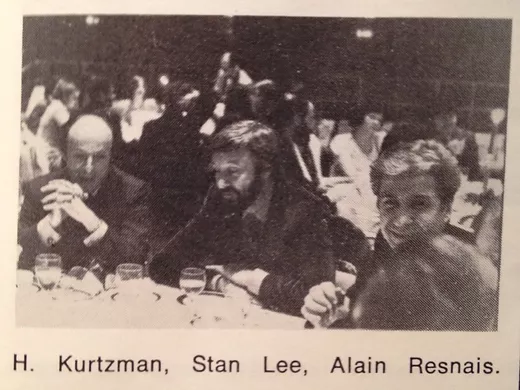
While he made some of the most treasured and opaque arthouse films in cinema, including “Last Year At Marienbad” and “Hiroshima Mon Amour,” the French filmmaker was a devoted comic-book fan since childhood (it’s how he learned English) and he had once hoped to adapt Herge’s Tintin book, “The Black Island” and the comic “Red Ryder.” He met the great Stan Lee in New York in 1971 and was instantly hooked by the comic book author’s “loveable” personality, “He told me that he has written more than 7000 stories, and would like to try something else,” Resnais told the Harvard Crimson the following year. But “The Inmates” would never go beyond a treatment—Resnais wanted a screenplay written by Lee himself and Lee wanted the auteur to find a script collaborator.
*
p.s. Hey. ** David Ehrenstein, I’ve heard that. ** tomk, Hi, T. oh, fuck, man. If I were God, I would reorder the way society works and give every writer I deemed especially talented — and, being God, I would have both impeccable tastes and a preference for daring, experimental writing, of course — a generous monthly stipend, but I’m unfortunately not God, so that sucks, man. There does seem to be a definite crossover between gigantism and vore. I mean an inordinate number of these giant fetishists either eat little people or get eaten in their videos, etc. Yes, my address, I’m so sorry to be slow. I’ll do it right this second. Hold on. Done! Hang in there, maestro. ** Suzy, Hi, Suzy! Welcome! That is such a great story! Thank you kindly. Who/how are you? You must be a writer (?) because that was a terrific paragraph. Thank you! ** Misanthrope, Prize winners, bleah! With obvious exceptions. Judgement by committee is just asking for compromise and the acceptable over the mind-blowing. Rain storms here tend to be pretty quick. Like just duck in a doorway for a couple minutes-style quick. Being not dead is the best! ** Sypha, You bring to mind that post you made for the blog ages ago that was nothing but a tall stack of women jiggling their huge breasts. I don’t think restoring that post in the current climate is necessarily a great idea? 42! Okay, now you’re talking. Gotcha on the cake thing. As you said, people are strange. ** _Black_Acrylic, Awww, that’s amazing. I can probably slip into Instagram and peek before the site blocks me. Not a bad story, the Hagan. Huh. ** Bill, I understand it, but I don’t feel it, if you know what I’m saying. Is Evenson a sci-fi writer? I guess he is or could be, okay. Well, yeah, that’s like using sci-fi for your own odd reasons or something? The election here was messy and not a good thing. As you probably read, the far right did much better than expected, and the unified left didn’t do as well as hoped. Macron didn’t get a parliamentary majority, and, in theory at least, that’s the one seeming bright spot. ** Robert, Hi, R. Well, if it’s any consolation, by the time I was, like, 20, I think I had already seen every kind of porn, extreme and otherwise, that existed, and that’s before the internet, obviously, so I had to see it by haunting porn stores and by mail order and sometimes via super8 movie projectors. Anyway, point is, excluding my questionable body of writing, I’m actually pretty sane and moral and all that stuff. Weird, huh? I’ve always preferred imagining sex and writing about it to having it. Okay, well, not always, ha ha. Choking is massively a thing, at least on the fetish sites I trawl for the related posts. It’s rare that guys there aren’t into it. Very trendy. Not sure why. I liked your digression. Digress away, man. ** Dominik, Hi!!! I have a weird imagination, but I think I can say I have never found my imagination slipping to the realm of macrophilia. Which is weird, now that I think of it. Yay, love will have a table permanently reserved for you and any guests you wish to accompany you. Someone surely has made a wedding dress out of fake nails, no? I mean apart from love. I might have to google that. Love starting a TikTok channel featuring him picking his nose and eating it that has 10 million subscribers, G. ** Billy, Hi. I remember that Sedaris story, wow. Trivia; I was the first person to ever publish David’s writing in a one-time zine I edited a long time ago called Farm Boys. It does seem like the sex fetish circuit has kind of settled into fetishising not very bizarre things like feet and Puppy Play. Weather’s back to rather marvelous here right now. Whew. Boy, I definitely hope you don’t have Monkeypox because of me. The guilt, oh my god. ** T, Thomas!! Hey, man! So very awesome to see you! I’ve been wondering where and how you are. You’re still in Calais, interesting. Uh, I’ve just mostly been a scrambling, stressed out film fund-raising chaser and worrier and so on. I’ve done a fair amount of other things, but that’s the horrible drone running through everything. Uh, maybe there was a giantess post here before? Huh. I’ll check, I cant remember. Awesome that the post you mentioned is coming together! Thank you, thank you! You can do it that way –everything in a WordDoc. If it’s possible for you to send the jpegs/images also as attachments to the email, that’s best because otherwise I have to screengrab them off the WordDoc which doesn’t always make for the best resolution. But I can do that. So either way. Cool! Thank you for that Tuesday. I don’t deserve it. But I’ll take it. I wish you a Tuesday like an atmosphere that’s been reverse-engineered such that the clouds and blue sky switch places. ** John Newton, I do think those old 50s or 60s or whatever ‘horror’ movies centered on giants must’ve been the impetus for the fetish, although I guess there were a number of fairytales using that premise beforehand, so never mind. I hope your visit with your friend has a lot of heart. I’ve never taken meds. I saw a therapist for a couple of years in the mid-90s, but not about compulsion, and it did seem to help me, strangely. Oh, I have a couple of friends who have compulsions like yours. They get by and don’t complain, although they do tend to apologise way too much. My immune system is so good that I never even got Covid. Or not yet. Covid seems to be kind of over here. Either that or people have just stopped getting tested, which could be the deal. ** Okay. I found this old post and thought it seemed like it deserved to be brought back to life. Make sense? See you tomorrow.




 Now available in North America
Now available in North America 
Dennis, Yeah, when that storm hit in Paris when we were there, we went down the steps of a Metro and hung out with a bunch of other people for about 10 minutes and then it was over.
I think the only thing that might recommend a steady all-day rain is the promise of it stopping.
It’s funny, I just told Sypha in a message that I think I excel at making it through the day without offing myself. I’m good at that. So far anyway, hahaha. It’s a thing.
Back to work today after maybe the most fucking boring 3-day weekend of my life. Other than the gym and a few meals, I did absolutely nothing. Was just bored out of my mind. And really couldn’t find the interest/passion to do anything. Just fucking vegetated. Ugh. Like not in a good way. Just sucked all the way around. I was actually looking forward to work last night. Erp.
Oh, well. But I’m still here. 😀
Godard’s “The Story”
Jim McBride’s “August-September”
Two Lost Films:
Andy Meyer’s “An Early Clue tothe New Direction”
Adolfas Mekas’ “Double-Barrelled Detective Story”
Aw, that Harold and the Purple Crayon looked like it would’ve been cool. You know how sometimes you see something and then you realized that it’s been years since you thought about it at all?–that’s the first time Harold and the Purple Crayon has been in my brain for a while.
Have you gotten any of this heat wave over there? It’s getting up to almost 100 in Indiana today, I think. Thank God I wasn’t born in paleolithic times.
And yeah, that’s true, and you did it back when it was actually risky–did you ever worry about your parents catching you? I had a laptop by the time I was old enough to masturbate compulsively, so I could just sit up in my room and shut the screen whenever my mom came in, but if you’re getting mail-order VHS pornos and stuff did you just have to watch those on the TV after everyone else went to sleep? But thanks for your response, hope your day goes well.
That’s sort of a dumb question, but I ask only because the fear of your parents walking in on you while you’re watching violent scat porn or something seems like it would be a lot more insurmountably intense than the fear of them walking in while you’re watching two people do missionary.
Odd that I’ve never heard about that Tarantino one. I AM familiar with Hitchcock’s KALEIDOSCOPE though. Shame it was never made, it sounds like it might have been interesting. I think I also read somewhere another title he was considering for it was FRENZY (years later he would shoot another film under that name, though with an unrelated story).
Ah yes, the boob tower, ha ha. Well, you know how these things go in phases, eventually I think people will tire of this New Puritanism.
Right now I’m halfway through the new James Nulick collection (LAZY EYES) and really enjoying it.
I would dearly love to see any one of these aborted films, but maybe especially Maldoror directed by Anger in his prime would be my pick of the pops.
Tomorrow I’ll be getting the toenail removed that has caused me so much anguish in recent months. Very much looking forward to seeing it go.
Hi!!
Me neither. I’ve heard about macrophilia before, but apart from knowing that it was a thing, I’ve never given it a second thought. It’s not our kink, I guess, haha.
Oh, fuck, that’s what I call quality content! The sad (?) thing is that I think love would actually have tons of subscribers, haha. Thank you. Love demanding an explanation as to why this new Peacock show is called “Queer as Folk” when it’s got nothing to do with the original show (which is love’s forever favorite, so he’s seriously upset about this!), Od.
P.S. Tomorrow, I’m off to a festival with Anita, and we might just laze around for a while after that as well, so I’ll only be back at the beginning of July. Such a very, very busy month for a hermit, haha! Have a lovely two(ish) weeks and see you soon!!
So many mouthwatering non-films today, sigh. I didn’t recognize the young Ian McKellen until I saw his byline. And I’d totally go see Who Killed Bambi.
Yeah Brian Evenson plays with sci-fi conventions enough that some of his books get marketed as sci-fi. Whether sci-fi fans agree is another matter, haha. I love the novels Immobility, or The Warren, more sci-fi settings in his recent stories as well.
Saw Mad God. It’s all about the visuals, often breathtaking. The music was sometimes annoying.
Bill
God, one of the saddest lists. Some of these I’ve heard of before, but many are new. That Hellman/Corman/Robbe-Grillet would undoubtedly have become my favorite film. Some truly mouth-watering possibilities here (Antonioni, Malick, Bresson, Cronenberg, among others)
Thanks for the sedaris trivia. So many of these sound so good. Ken Russell’s Dracula and Visconti’s Proust especially. I read somewhere that Derek Jarman tried to adapt james purdy’s narrow rooms but purdy wasn’t having it, so there’s another lost gem. You’re right about fetish stuff; it’s weird how not weird it is now. Could it have to do with the people in it not wanting to be known for weird shit; typecast, if that’s the word here? The times, how they decline, etc.
Daddy Issues
Hi Dennis, this is the list of lists! It’s really sweet and surprising. My favourite is the funny interaction between Polanski and Beckett. Although Polanski is one of my favourite directors, I believe he and Beckett are very different in terms of both style and vision, so the result would’ve been a total car crash… Don’t you think? I am no Beckett fan, but he was absolutely right about this. Also, ‘purist bastard’ just became my favourite insult! Thank you very much.
Hope your summer days are as exciting as you xo
After looking at this list, we’re lucky that Phil Tippett managed to finish MAD GOD.
My June music roundup for Gay City News (including 070 Shake, MUNA and Bartees Strange) just came out: https://gaycitynews.com/joy-and-heartbreak-in-junes-music/. So did my review of Porcupine Tree’s new album for Slant Magazine: https://www.slantmagazine.com/music/porcupine-tree-closure-continuation-review/
I’ll be writing about the new Perfume Genius album for my July music roundup. It surprised me – it’s heavily influenced by classical music and far more oriented towards texture than pop hooks or structures. I think it emerged out of a dance score, which makes sense.
Hey, Dennis! We’ve crossed internet paths a few times here and there. I read the blog all the time but maybe have commented twice in the past, what, ten years? + We’re friends on Facebook. And yes, I am a writer, in large part thanks to your influence.
I’ve been reading Hogg since you had it featured here on the blog. I’ve read more of Delany’s interviews than his actual writing, so I finally took the leap with what’s probably his least exemplary work and it definitely fucks hard, so thank you for the recommendation!
As for these dead movies, I have to say there’s a hole in my heart the size of Dumbo 2. Maybe we can at least get Bride of Pinocchio one of these days.
Thanks Dennis, unfortunately I was unable to visit my friend as his doctors and surgeons are still running tests on him, and from what his relatives told me he is able to open his eyes and move his one hand and leg, and they do not want to overwhelm him or confuse him.
Some of those dead or destroyed/never made films are ones I wish had been made such as the Rainer Werner Fassbinder epic cocaine, does the 600 page script exist or has it ever been published with the complete unedited text?
I used to loathe going to adult bookstores or porn stores as I was not always of age, and I would get heavily cruised when I would go in to buy porn on VHS tapes, magazines, and adult books. I never had sex with any men in the adult bookstore but I was well aware that police would sometimes arrest people for doing this, just for being in a public sex cruising area, or for just talking to someone undercover and cruising/flirting with them. I took a gay friend in one once and he became nervous immediately and wanted to leave, so we did.
It is a bit odd to me how super mainstream the whole dog/puppy/horse roleplay sex kink now is, and how fisting as well. I thought it had peaked in the 1970s-early 2000s?
I have met people into the choking sex kink and an unfortunate experience meeting one by surprise in person made me realize I am not well suited for sex with strangers at all, and I am better off staying single or better suited for dating women and men since if someone gets weird or stalks me I put an end to it. I did see a therapist when two friends committed suicide and it was very helpful for depression.
When you lived in NYC, did you ever go to the mineshaft, piers, the original or later new St Mark’s baths, or mainly just to the 9th circle bar/Julius’ bar, CBGBs, and the mudd club?
What are your thoughts on MFAs, advanced university degrees, or the publishing industry today? I was told I should get a Master’s in English decades before COVID, or a PhD in rhetoric but the super expensive cost of either and the ultra-competitive job market in academia among other reasons was a major factor in me not pursing any graduate degree. I felt as though I would become too overqualified in a small field, and after graduating from a university I had enough of writing academic papers, speaking or lecturing in classes or at literature conferences, etc.
Have a good rest of your week.
When I met Richerd Linklater – back in the beginning of his career – he told me of his desire to do a version of Hunger, set in contemporary Corpus Christi. It seems that at that time the Hamsun estate would not give him permission. He also talked about diong a doc about Nadine Nortier (Mouchette) and what became of the her after her her iconic role in Bresson’s masterpiece.